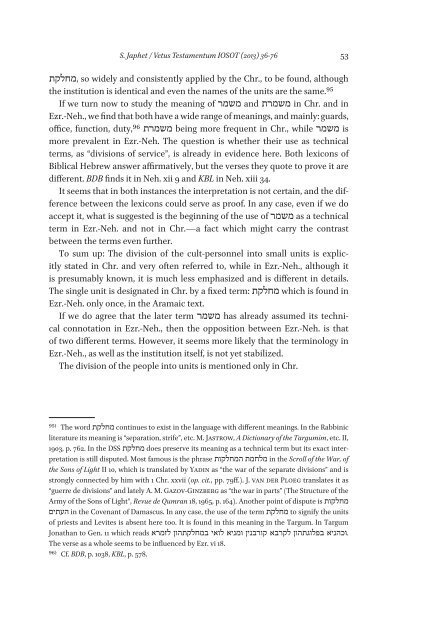Special Issue IOSOT 2013 - Books and Journals
Special Issue IOSOT 2013 - Books and Journals
Special Issue IOSOT 2013 - Books and Journals
Create successful ePaper yourself
Turn your PDF publications into a flip-book with our unique Google optimized e-Paper software.
S. Japhet / Vetus Testamentum <strong>IOSOT</strong> (<strong>2013</strong>) 36-76 53<br />
so widely <strong>and</strong> consistently applied by the Chr., to be found, although ,מחלקת<br />
the institution is identical <strong>and</strong> even the names of the units are the same.95<br />
If we turn now to study the meaning of משמר <strong>and</strong> משמרת in Chr. <strong>and</strong> in<br />
Ezr.-Neh., we find that both have a wide range of meanings, <strong>and</strong> mainly: guards,<br />
office, function, משמרת duty,96 being more frequent in Chr., while משמר is<br />
more prevalent in Ezr.-Neh. The question is whether their use as technical<br />
terms, as “divisions of service”, is already in evidence here. Both lexicons of<br />
Biblical Hebrew answer affirmatively, but the verses they quote to prove it are<br />
different. BDB finds it in Neh. xii 9 <strong>and</strong> KBL in Neh. xiii 34.<br />
It seems that in both instances the interpretation is not certain, <strong>and</strong> the difference<br />
between the lexicons could serve as proof. In any case, even if we do<br />
accept it, what is suggested is the beginning of the use of משמר as a technical<br />
term in Ezr.-Neh. <strong>and</strong> not in Chr.—a fact which might carry the contrast<br />
between the terms even further.<br />
To sum up: The division of the cult-personnel into small units is explicitly<br />
stated in Chr. <strong>and</strong> very often referred to, while in Ezr.-Neh., although it<br />
is presumably known, it is much less emphasized <strong>and</strong> is different in details.<br />
The single unit is designated in Chr. by a fixed term: מחלקת which is found in<br />
Ezr.-Neh. only once, in the Aramaic text.<br />
If we do agree that the later term משמר has already assumed its technical<br />
connotation in Ezr.-Neh., then the opposition between Ezr.-Neh. is that<br />
of two different terms. However, it seems more likely that the terminology in<br />
Ezr.-Neh., as well as the institution itself, is not yet stabilized.<br />
The division of the people into units is mentioned only in Chr.<br />
95) The word מחלקת continues to exist in the language with different meanings. In the Rabbinic<br />
literature its meaning is “separation, strife”, etc. M. Jastrow, A Dictionary of the Targumim, etc. II,<br />
1903, p. 762. In the DSS מחלקת does preserve its meaning as a technical term but its exact interpretation<br />
is still disputed. Most famous is the phrase מלחמת המחלקות in the Scroll of the War, of<br />
the Sons of Light II 10, which is translated by Yadin as “the war of the separate divisions” <strong>and</strong> is<br />
strongly connected by him with 1 Chr. xxvii (op. cit., pp. 79ff.). J. van der Ploeg translates it as<br />
“guerre de divisions” <strong>and</strong> lately A. M. Gazov-Ginzberg as “the war in parts” (The Structure of the<br />
מחלקות Army of the Sons of Light”, Revue de Qumran 18, 1965, p. 164). Another point of dispute is<br />
to signify the units מחלקת in the Covenant of Damascus. In any case, the use of the term העתים<br />
of priests <strong>and</strong> Levites is absent here too. It is found in this meaning in the Targum. In Targum<br />
.וכהניא בפלוגתהון לקרבא קורבנין ומניא לואי במחלקתהון לזמרא Jonathan to Gen. 11 which reads<br />
The verse as a whole seems to be influenced by Ezr. vi 18.<br />
96) Cf. BDB, p. 1038, KBL, p. 578.








![Am HaSefer [Volk des Buches] - Books and Journals](https://img.yumpu.com/20648352/1/174x260/am-hasefer-volk-des-buches-books-and-journals.jpg?quality=85)







